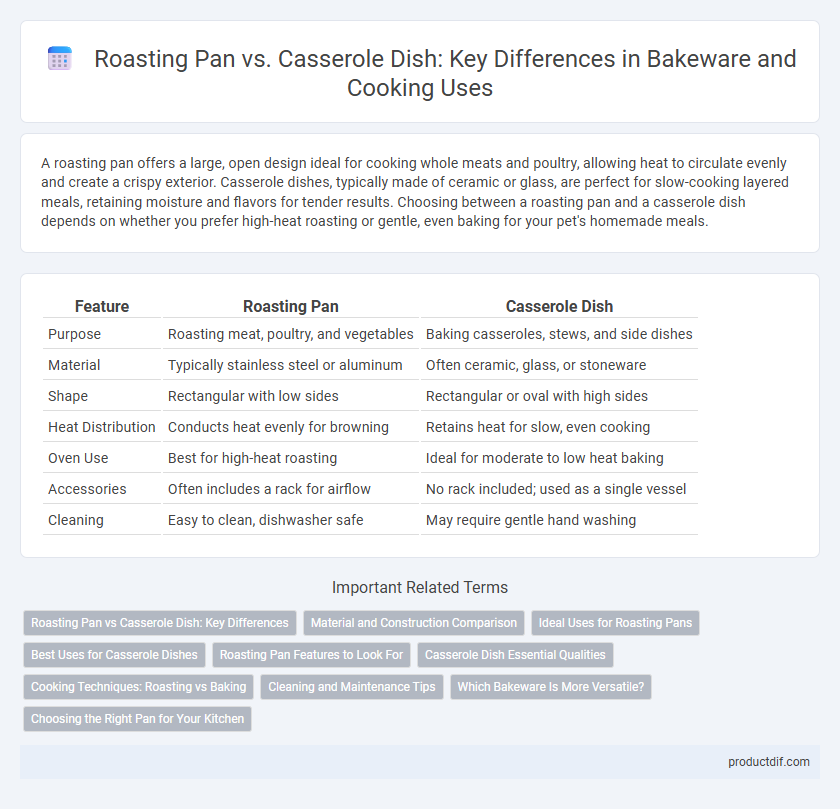A roasting pan offers a large, open design ideal for cooking whole meats and poultry, allowing heat to circulate evenly and create a crispy exterior. Casserole dishes, typically made of ceramic or glass, are perfect for slow-cooking layered meals, retaining moisture and flavors for tender results. Choosing between a roasting pan and a casserole dish depends on whether you prefer high-heat roasting or gentle, even baking for your pet's homemade meals.
Table of Comparison
| Feature | Roasting Pan | Casserole Dish |
|---|---|---|
| Purpose | Roasting meat, poultry, and vegetables | Baking casseroles, stews, and side dishes |
| Material | Typically stainless steel or aluminum | Often ceramic, glass, or stoneware |
| Shape | Rectangular with low sides | Rectangular or oval with high sides |
| Heat Distribution | Conducts heat evenly for browning | Retains heat for slow, even cooking |
| Oven Use | Best for high-heat roasting | Ideal for moderate to low heat baking |
| Accessories | Often includes a rack for airflow | No rack included; used as a single vessel |
| Cleaning | Easy to clean, dishwasher safe | May require gentle hand washing |
Roasting Pan vs Casserole Dish: Key Differences
Roasting pans are designed with low, wide sides and a sturdy rack to ensure even heat circulation and optimal browning for large cuts of meat, while casserole dishes feature higher sides and a lid, ideal for slow-cooking and baking layered ingredients. The material composition differs, with roasting pans often made of heavy-gauge stainless steel or aluminum for durability and heat conduction, and casserole dishes commonly made of ceramic or glass to retain moisture. Size and shape variations cater to their cooking methods, making roasting pans preferable for dry-heat roasting and casserole dishes better suited for moist-heat baking.
Material and Construction Comparison
Roasting pans are typically constructed from heavy-duty materials like stainless steel or cast iron, designed to withstand high oven temperatures and provide even heat distribution for roasting meats. Casserole dishes often feature ceramic or glass construction, which offers superior heat retention and aesthetic appeal for serving but can be less responsive to temperature changes. Both materials affect cooking performance, with metal pans favoring a crispy exterior and ceramic dishes excelling in slow, moist baking.
Ideal Uses for Roasting Pans
Roasting pans are ideal for cooking large cuts of meat, such as whole chickens, turkeys, and roasts, as they provide even heat distribution and ample space for browning and caramelization. Their high sides effectively contain juices and prevent splatters, making them perfect for roasting vegetables alongside meats. Unlike casserole dishes, roasting pans often include racks that elevate food, promoting airflow and ensuring crispy, evenly cooked results.
Best Uses for Casserole Dishes
Casserole dishes excel at slow-cooking meals such as stews, lasagnas, and baked pasta, providing even heat distribution and moisture retention. Their deep, wide design accommodates layered ingredients, allowing flavors to meld over long cooking periods. Ideal for oven-to-table serving, ceramic or glass casserole dishes combine functionality with aesthetics for family-style presentations.
Roasting Pan Features to Look For
A roasting pan features sturdy construction, often made of stainless steel or heavy-gauge aluminized steel, ensuring even heat distribution and durability. Look for high sides to contain juices and prevent splatters, along with a tight-fitting lid or roasting rack for optimal airflow and meat caramelization. Non-stick or enameled surfaces enhance cleanup and resist sticking, while oven-safe handles provide secure grip during high-temperature cooking.
Casserole Dish Essential Qualities
Casserole dishes are essential for their versatility, typically made from materials like ceramic, glass, or enameled cast iron that provide even heat distribution and retain moisture during cooking. Their design, often with high sides and a tight-fitting lid, makes them ideal for slow cooking, braising, and baking a variety of dishes such as stews, gratins, and baked pasta. The ability to transition from oven to table, along with easy cleaning and durability, distinguishes casserole dishes as indispensable bakeware for both everyday meals and special occasions.
Cooking Techniques: Roasting vs Baking
Roasting pans are designed for high-heat cooking methods that promote browning and caramelization, making them ideal for roasting meats and vegetables with dry heat. Casserole dishes are optimized for baking techniques that use moist heat to evenly cook ingredients, perfect for layered or slow-cooked meals like casseroles and gratins. The thick walls of casserole dishes retain moisture, while roasting pans typically have a low, wide profile to allow airflow and crisping.
Cleaning and Maintenance Tips
Roasting pans typically feature a non-stick surface requiring gentle hand washing with mild detergent to preserve coating integrity, while casserole dishes, often made of ceramic or glass, are dishwasher safe and resistant to staining. To maintain a roasting pan, avoid abrasive scrubbers that can damage the finish and always dry thoroughly to prevent rust. For casserole dishes, soaking after use prevents baked-on residue buildup and regular inspection for chips enhances longevity and safety.
Which Bakeware Is More Versatile?
A roasting pan offers broad versatility with its large size and sturdy construction, ideal for roasting meats, vegetables, and even baking large casseroles. Casserole dishes, typically ceramic or glass, excel in evenly cooking layered dishes and are oven-to-table convenient but have limited capacity compared to roasting pans. For diverse cooking methods and volume flexibility, roasting pans generally provide more versatility in the kitchen.
Choosing the Right Pan for Your Kitchen
Selecting the right pan for your kitchen depends on the cooking method and dish type; roasting pans excel at high-heat oven roasting of meats with their sturdy construction and often come with roasting racks for even heat distribution. Casserole dishes are ideal for slow-cooking, baking, and serving layered meals, typically made from ceramic or glass to retain moisture and offer attractive presentation. Understanding the purpose of each helps optimize cooking results and enhances kitchen versatility.
Roasting Pan vs Casserole Dish Infographic

 productdif.com
productdif.com